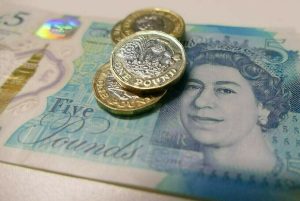POUND HEADS FOR WORST MONTH SINCE 2022 BUDGET CRISIS
The pound headed towards its largest monthly loss against the dollar since September 2022 on Thursday, reflecting growing confidence among investors in the outlook for the U.S. economy and increasing pessimism over the British one. Sterling was down 0.15% on the day at $1.322 and weakened against the euro, which rose 0.4% to 86.46 pence. In July, the pound has fallen by 3.7%, the most since losing 3.9% and hitting a record low in September 2022, during then-Prime Minister Liz Truss’s budget-induced market crisis. The pound is still up nearly 6% against the dollar this year, but that’s softened dramatically from a year-to-date gain of almost 10% at the start of the month. Following Wednesday’s two-day policy meeting, the Federal Reserve left U.S. interest rates unchanged, as expected, and Chair Jerome Powell gave no indication of when they might fall again. In the meantime, U.S. data has painted a far rosier picture of the world’s largest economy than UK data has of the British economy. U.S. data releases this week including second-quarter economic activity and some measures of employment have added to that. The Citi U.S. economic surprise index has overtaken its UK counterpart this week for the first time since April. With the Bank of England expected to almost certainly deliver two more rate cuts this year, according to money markets, and a far lower chance of two more cuts from the Fed, investors are ditching the pound. Weekly data from the U.S. Commodity Futures Trading Commission shows speculators are neutral on the pound, having whittled back the bullish positioning that had prevailed continuously since February. “Although not in receipt of any tier-one data releases this week, sterling has still had a bumpy ride,” analysts at Monex said in a note. “Slowing U.S. growth and UK fiscal concerns both point to sterling underperformance moving forward. As such, we see little room for sterling to rally sustainably from current levels sub-$1.33,” they said.

DOLLAR SET FOR FIRST MONTHLY GAIN OF 2025 AS TRADE DEALS EASE UNCERTAINTY
The U.S. dollar was headed for its first monthly gain for 2025 against major currencies on Thursday, underpinned by easing trade tensions and U.S. economic resilience. The dollar rose against the yen, trading at its highest level since May 28. It is on track to gain about 5% for July, making it the biggest monthly increase since December 2024. It was last up 0.83% at 150.765. In a widely expected move, the Bank of Japan on Thursday kept short-term interest rates steady at 0.5% by a unanimous vote, but revised up its inflation forecasts for the next few years. That came after the Federal Reserve left U.S. interest rates unchanged on Wednesday, ignoring persistent calls by President Donald Trump to lower borrowing costs. Fed Chair Jerome Powell also indicated he was in no rush to cut rates. The greenback has been bolstered by a hawkish Fed and U.S. economic resilience, with uncertainty over Trump’s chaotic tariffs easing after an array of trade deals. The dollar index was up 0.16% at 99.949 after rising nearly 1% in the previous session. It is on track for the first monthly gain in 2025. “There’s been a clash and a friction between what the Fed is seeing and deciding to do, and what the White House and perhaps a lot of people in the equity market want the Fed to do,” said Juan Perez, director of trading of Monex USA in Washington. “If we had left the hawkish tone, the hawkish stance, and the hawkish press conference altogether, it makes sense to see the U.S. dollar rise – which it did. But today, because of the friction between the Fed and the White House, the dollar is once again hitting the brakes,” Perez added. Data showed that the number of Americans filing new applications for unemployment benefits increased just marginally last week, suggesting that the U.S. labor market remained stable. The euro has been one of the biggest casualties of the dollar’s ascent this month, as investors have rushed to unwind bets laid on earlier this year on the premise that the European market may offer better opportunities. The euro was last up 0.19% at $1.1426, having hit a seven-week low on Wednesday. Still, it remained on track to lose nearly 3% this month. “I think there was too much optimism in the price of the euro. And I think that’s come back this week. There’s been a lot of commentary about how the EU conceded to the U.S. on this trade deal and that’s been a dose of reality for the Europeans,” Rabobank strategist Jane Foley said. The dollar weakened 0.31% against the Swiss franc to 0.812 franc but it is on track to gain 2.36% for the month. The European Union’s agreement on Sunday to 15% tariffs on U.S. exports has cleared up a lot of uncertainty. BOJ Governor Kazuo Ueda also said the U.S.-Japan trade deal reduced uncertainty on the outlook and heightened the likelihood of Japan durably hitting the BOJ’s 2% inflation target – a prerequisite for further rate hikes.
DOLLAR TUMBLES, TRADERS BET ON MORE US RATE CUTS AFTER WEAK JOBS REPORT
The dollar dropped on Friday and was on track for its biggest daily loss against the yen since January 2023 after data showed that U.S. employers added fewer jobs in July than economists had expected, while last month’s jobs gains were revised sharply lower, leading traders to ramp up bets on how many times the Federal Reserve is likely to cut rates this year. Employers added 73,000 jobs last month, below the 110,000 expected by economists polled by Reuters, while the unemployment rate edged higher to 4.2%, as anticipated, up from 4.1% in June. Job gains for June were revised down to 14,000, from the previously reported 147,000. “It’s worse than anyone expected and the kicker is that downward revision for the prior month too,” said Helen Given, director of trading at Money USA in Washington. The dollar index, which measures the greenback against a basket of currencies including the yen and the euro, was last down 1.23% on the day at 98.80. The euro rose 1.37% to $1.1571 and was on track for its biggest daily gain since April. The single currency reached $1.1389 earlier on Friday, the lowest since June 10. Against the Japanese yen, the dollar weakened 2.23% to 147.37. The greenback earlier reached 150.91, the highest since March 28. The Fed has indicated it is in no rush to cut rates due to concern that President Donald Trump’s tariff policies will reignite inflation over the coming months. Fed funds futures traders pared bets on how many times the U.S. central bank is likely to cut rates this year after Fed Chair Jerome Powell on Wednesday offered a hawkish outlook for monetary policy and declined to indicate that a cut in September was likely. But they ramped up bets on cuts again on Friday after the jobs data. Traders are now pricing in 63 basis points of cuts by year-end, up from around 34 basis points on Thursday, with the first cut seen in September. The dollar extended its drop on Friday after the Fed said Governor Adriana Kugler was resigning from the Federal Reserve effective Aug. 8. Trump on Friday also ordered that the commissioner of the Labor Department’s Bureau of Labor Statistics Erika McEntarfer be fired after the weaker than expected jobs data and downward revisions. Whether the Fed cuts in September may now depend on the next jobs report for August. “(Powell) did say on Wednesday that we were looking at holding rates steadier for longer, but that we were going to get two sets of employment data before the next Fed meeting. So as this first set has been so decidedly negative… the labor market is clearly, clearly cooling, that’s going to raise the importance of that September figure as well,” said Given. The August jobs data will be released on September 5, with the Fed due to meet on September 16-17. A more dovish Fed would likely be negative for the U.S. currency, even after it has appeared to find its footing in recent weeks following a rough first half of the year. “Our forecast for the dollar to strengthen in the second half of the year relies in large part on our view that the US economy will remain resilient and the FOMC keep policy on hold until 2026,” Jonas Goltermann, deputy chief markets economist at Capital Economics said in a note. “Plainly, that now looks less probable; in a recession scenario the dollar is likely to weaken against lower yielding currencies such as the yen and the euro, even if it may rally against other, riskier currencies,” he said. The dollar had gained earlier on Friday after Trump imposed new tariff rates on dozens of trade partners. The Swiss franc was among the hardest hit as Switzerland now faces a 39% rate. The Swissie fell against a range of currencies in response to Trump’s hefty duties and to his demand that pharma companies – key Swiss exporters – lower the prices at which they sell to U.S. consumers. The dollar was last down 0.9% against the Swiss franc at 0.805, after earlier reaching 0.8171, the highest since June 23. The Canadian dollar strengthened 0.43% versus the greenback to C$1.38 per dollar, after earlier easing to C$1.3879, the weakest since May 22. Canada was hit with a 35% tariff, instead of the threatened 25%. The dollar had also gained against other currencies due to drivers other than tariffs. The yen was earlier headed for its largest weekly loss this year after the Bank of Japan signaled it was in no hurry to resume interest rate hikes, prompting Finance Minister Katsunobu Kato to say on Friday that officials were “alarmed” by currency moves. In cryptocurrencies, bitcoin fell 2.65% to $113,432.

STERLING STEADIES AFTER WORST MONTHLY PERFORMANCE SINCE 2022
The pound held steady on Friday, having posted its worst monthly performance against the dollar in three years, as the U.S. currency rallied after President Donald Trump imposed new tariff rates on dozens of trade partners. Sterling lost nearly 4% in value in July, its biggest monthly decline since September 2022’s so-called “mini-budget crisis” that drove the currency to a record low against the dollar and sparked turmoil across the UK bond market. The Bank of England meets next week and is widely expected to cut interest rates by a quarter point to 4%, their lowest in 2-1/2 years. The pound was last flat on the day at $1.3203, near its lowest since mid-May, having struck a near four-year high of $1.3787 just a month ago. Friday’s U.S. nonfarm payrolls report is likely to be key in either cementing the dollar’s recent rally or bringing it to an end. A reading above the 110,000-increase forecast in a Reuters poll of economists could give the dollar an even bigger boost, especially as the worst fears over the impact of U.S. tariffs have ebbed. “This dynamic is unlikely to change ahead of the weekend either, with little of note in the UK calendar for today. That leaves U.S. events top of mind for sterling traders, with uncertainty the dominant theme,” Monex analysts said. The biggest catalyst driving the pound down has been the deterioration in UK economic data. The BoE, among the more conservative of the major central banks when it has come to lowering borrowing costs, is now expected to deliver more rate cuts in the coming six months than either the European Central Bank or the Federal Reserve, based on money markets.

DOLLAR ADVANCES AGAINST PEERS AFTER STRONG GDP DATA, FED HOLDS KEY INTEREST RATE STEADY
The dollar advanced against major peers on Wednesday following better-than-expected U.S. GDP data and as the Federal Reserve held interest rates steady at its July meeting. The Federal Reserve left interest rates unchanged, rebuffing persistent calls by President Donald Trump to cut interest rates. The federal funds rate will continue to be set in a range between 4.25% to 4.5%. At a news conference on Wednesday afternoon, Federal Reserve Chair Jerome Powell said that no decision has been made for September and that the central bank must wait and see the impact of tariffs before acting. U.S. economic growth rebounded more than expected in the second quarter, expanding by 3% compared with an estimate of 2.4% based on a Reuters poll of economists. The euro extended losses against the dollar. It was down 0.5% to $1.1493, on track for the fifth straight session of losses and trading at its lowest level since June 23. The euro is also poised to record its first monthly drop in 2025, following a sharp reaction to a U.S.-European Union trade deal earlier this week. The dollar index added to its gains. It was up 0.4% at 99.29, on course to post its first month of gains this year. Trade agreements struck with Japan last week and the EU over the weekend signaled a renewed U.S. commitment to global engagement, easing investor concerns. Investors’ focus is now on negotiations between China and the U.S. after officials agreed to seek an extension of their 90-day tariff truce. But Trump upped the ante against India on Wednesday, announcing that a 25% tariff on imports starting August 1. “Trump can afford to be harsh on India because he’s gotten a bunch of deals already and he’s trying to pressure them to be more forthcoming. . . I don’t think the tariffs will end as harsh as he hinted but he does want to negotiate with India on terms favorable to the U.S.,” said Steve Englander, head of global G10 FX Research at Standard Chartered in New York. Data showed on Wednesday that the German economy contracted in the second quarter, while France’s economy beat forecasts. The spotlight will be on comments from BoJ Governor Kazuo Ueda as investors hope the trade deal between Japan and the U.S. paves the way for the central bank to raise rates on Thursday. The dollar was firmer 0.1% to 148.64 against the yen, hitting a two-week high. Against the Swiss franc, the dollar strengthened 0.65% to 0.811 francs, reaching its highest since June 24.
- CAPITALDIGEST MARKET REVIEW , 03/11/2025November 3, 2025
- CAPITALDIGEST DAILY NEWS, 03/11/2025November 3, 2025
- CAPITALDIGEST MARKET REVIEW, 22/09/2025September 22, 2025
Enter your email address for receiving valuable newsletters.
- CAPITALDIGEST MARKET REVIEW , 03/11/2025US DOLLAR SET FOR MODEST WEEKLY GAIN AFTER SOFT INFLATION DATA The U.S. dollar was...November 3, 2025
- CAPITALDIGEST DAILY NEWS, 01/09/2025DANGOTE’S 1,000 TRUCKS ARRIVE, FUEL DISTRIBUTION TO BEGIN FROM S’WEST Barring any last-minute change in...September 1, 2025
- CAPITALDIGEST MARKET REVIEW, 11/08/2025STERLING ADVANCES AGAINST DOLLAR, EURO AHEAD OF BOE POLICY ANNOUNCEMENT The British pound climbed against...August 11, 2025












